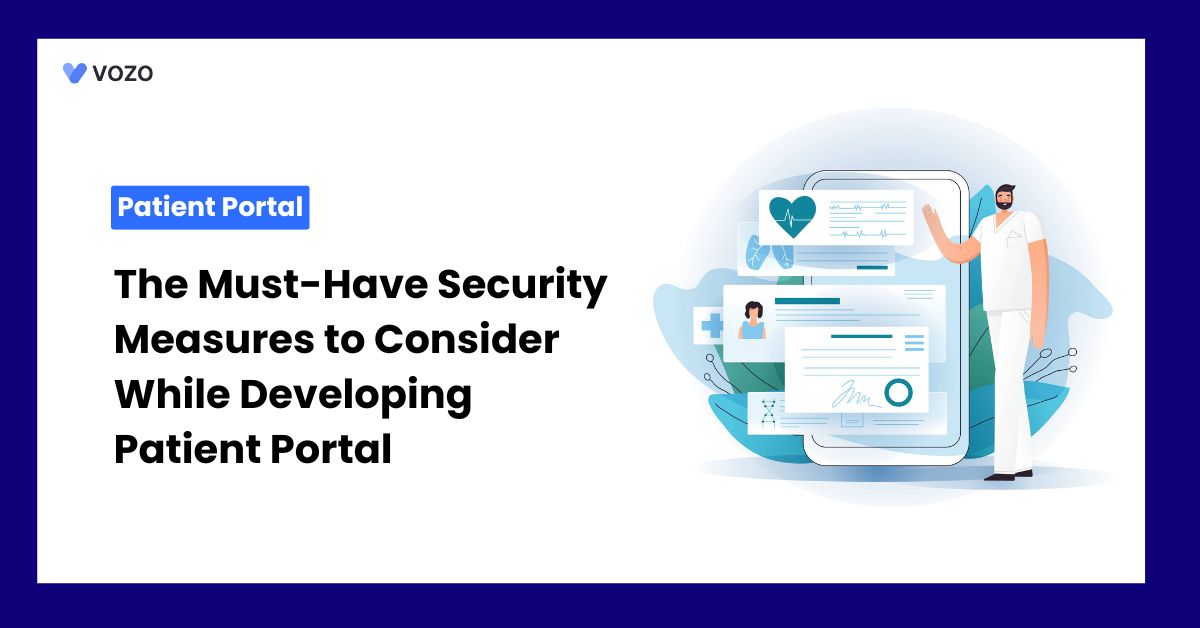The Must-Have Security Measures to Consider While Developing Patient Portal
In 2024, healthcare data breaches reached a record high of 725. Each breach impacted at least 500 individuals across different healthcare systems. The Change Healthcare cyberattack exposed data from 190 million patients. This was the largest healthcare breach ever recorded in the industry.
Cybercriminals target patient portals to steal medical records and identities. Stolen health data is used for fraud, ransomware, and illegal activities. The cost of a healthcare data breach averages $10.93 million per incident. Strong security measures protect patient information from growing cyber threats. Healthcare providers must prioritize cybersecurity to prevent data leaks and financial losses.
In this blog post, we have shared the essential security measures to consider while developing a patient portal platform.
Why Patient Portals Are a Prime Target for Cyber Attacks
Patient portals store protected health information, including:
- Patient information like name, contact details, address, and social number.
- Medical records, medications, and test results.
- Payment and insurance details
Hackers find this data valuable for financial and medical fraud.
Unlike credit cards, medical records cannot be replaced easily. Stolen medical records are sold on dark web marketplaces. Hackers use patient data to
- Medical identity theft is seeking treatment under a false identity.
- Financial fraud: utilizing insurance information to file fake claims.
- Ransomware attacks, locking access to patient data until a ransom is paid.
Related: Patient Portals 2024: Latest Trends, Features, and Benefits
According to reports, healthcare data breaches cost millions per incident. Attackers use ransomware to lock access to critical medical records. Hospitals may pay ransoms to restore patient data access.
Cybercriminals also exploit weak passwords and poor security configurations. Implementing strong security reduces the risk of unauthorized access.
Essential Security Measures Every Patient Portal Needs
1. Data Encryption: The Initial Phase of Defense
Encryption makes stolen data unreadable without the proper decryption key. It protects information during storage and data transmission.
- Secure data transfer using TLS 1.3. This prevents attackers from intercepting sensitive patient information.
- Use AES-256 encryption for stored data. Even if accessed, encrypted data remains unreadable without proper keys.
- Replace sensitive data with random tokens for protection. Tokenized data reduces risk during breaches or unauthorized access.
Strong encryption ensures patient data remains secure from cyber threats.
2. Strong Authentication & Access Control
Weak passwords make portals vulnerable to brute-force hacking attempts. Strong authentication prevents unauthorized logins and data breaches.
- Requires passwords plus an extra security step. This includes biometric authentication or one-time passcodes.
- Restricts access based on job roles. Doctors access records, but receptionists only manage appointments.
- Prevents repeated failed login attempts. Sessions expire automatically after a period of inactivity.
These measures prevent unauthorized users from accessing patient information.
3. Secure API Integrations
Patient portals connect with Electronic Health Records and payment systems. Weak API security can expose sensitive healthcare data.
- Use secure authentication protocols. These ensure that only authorized systems access patient information.
- Share only necessary data between different systems. Reducing data exposure limits the risk of security breaches.
- Conduct penetration tests to find vulnerabilities. Fix weak API configurations before attackers exploit them.
Secure APIs protect patient data from unauthorized system integrations.
4. Regular Security Audits & Monitoring
Continuous security monitoring detects suspicious activity before breaches happen. Regular audits help healthcare providers identify vulnerabilities.
- Record user activity and file access. Track login attempts and data modifications for security monitoring.
- Monitor for abnormal network activity. Detect and respond to cyber threats in real-time.
- Conduct penetration tests and vulnerability scans. Regular assessments help address security risks proactively.
Continuous monitoring strengthens security and prevents patient data leaks.
5. Compliance & Regulatory Adherence
Healthcare providers must follow laws to protect patient data. Non-compliance results in heavy fines and legal penalties.
- Requires strict healthcare data protection standards. Encryption and access control are mandatory for patient portals.
- Ensures patient data privacy and consent-based sharing. Patients have the right to access and delete their data.
- Verifies compliance with healthcare security standards. Healthcare organizations follow strict security and risk management practices.
- Educate employees on data protection best practices. Human error is a leading cause of data breaches.
Following regulations prevents legal issues and maintains patient trust.
Related: 10 Major Factors to Consider While Choosing a Patient Portal Platform
Cyber threats continue to target healthcare organizations and patient portals. Data breaches lead to financial losses, lawsuits, and patient distrust.
Healthcare providers must prioritize security from the development stage. Encryption, authentication, and monitoring reduce risks significantly. A secure patient portal ensures compliance and protects sensitive information.
Vozo Patient Portal for Better Health Management
Vozo patient portal software has incredibly empowered patients with advanced & simplified portal features. This includes secure one-to-one messaging and easy appointment scheduling.
It also provides easy access to lab reports and record consultations. Requesting and refilling e-prescriptions are way too simple now.
Your Problems:
- Integration or implementation issues?
- Doubting the support system?
- Looking for a portal under your budget?
- Switching or upgrading to the Vozo patient portal?
- Finding troubles with usage or functions?
- Are you facing an issue with getting patients to opt in?
- Security concerns?
- Need a customized portal for your specialty?
Our Solutions:
- Our software can be easily implemented & integrated with any EHR system. It improves practice workflow and productivity.
- Our team of professionals is readily available 24/7 to get things done for you, no matter what your practice size.
- Vozo patient portal fits your budget perfectly with monthly subscription plans.
- Switching to our portal is a straightforward process; you won’t need any help, yet our team has your back.
- We provide various step-by-step tutorials and help to get you on track with the portal.
- Our portal is simple to use and understandable to all. Once they get to try this, there will be no turning back.
- Our portal has strong privacy and security safeguards in place.
- Vozo Patient Portal can be exclusively customized to satisfy your specific specialty requirements and workflow.
“Let’s empower your patients with the best cost-effective patient portal together”
About the author

With more than 4 years of experience in the dynamic healthcare technology landscape, Sid specializes in crafting compelling content on topics including EHR/EMR, patient portals, healthcare automation, remote patient monitoring, and health information exchange. His expertise lies in translating cutting-edge innovations and intricate topics into engaging narratives that resonate with diverse audiences.













